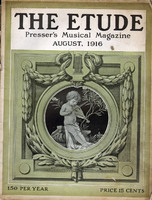Twenty-five years ago the average piano student in America could not consider his repertoire complete unless it included Leybach’s Fifth Nocturne. Never a composition of more than mediocre merit, it was nevertheless the musical forge upon which was hammered out many and many a primitive musical career. We played it, we sang it, we whistled it, we pounded it, we tortured our neighbors with it, we did everything we possibly could to it and with it, and in the end stood unashamed before the world. When it was put into the shade by the greater lights of the real masters we still went back to the old Fifth Nocturne to find out why it was that it charmed us so, why it was on thousands of recital programs.
The Etude has recently been conducting a careful audit of 150 recital programs given by teachers in all parts of the United States. These were taken just as they have come to us. Some are from the leading conservatories in large Eastern and Middle Western cities. Others come from towns and villages “everywhere.” The examination was as fair as anything could possibly be. Out of two thousand compositions recorded Leybach’s Fifth Nocturne appears only once. Yet, in certain districts where musical culture may not as yet have reached as high a standard as in some others, the Fifth Nocturne would still make a very successful recital piece. Many teachers would do well to consider the capacity of their audiences at recitals.
The audit was a revelation in more ways than one. According to these programs (which, by the way, covered a period of two years) the most used composers are:
|
63 |
|
|
61 |
|
|
55 |
|
|
44 |
|
|
40 |
|
|
38 |
|
|
37 |
|
|
34 |
|
|
28 |
|
|
26 |
The numbers after the names state the times which compositions of these composers appeared on the programs. While this cannot be said to be wholly conclusive in estimating the musical taste of our country, the great number and variety of districts represented and the period of time covered certainly make these figures straws which show how the wind blows.
That the first ten in popularity are admitted great masters, and that an American composer is among them, must be very gratifying to American readers. It shows what excellent work the teachers of the country are actually doing. If it were desirable to publish the remainder of the list our readers would find some very surprising things. For instance, Handel is represented by only seven compositions, Gottschalk by five (more’s the pity), Henselt by three, Gluck by one, and Sir Arthur Sullivan by one. Brahms stands much higher in the list than Tchaikovsky, Scharwenka, Leschetizky, Rachmaninoff and Debussy. The names of many much-vaunted American composers are conspicuous by their absence, but there is a most encouraging representation of the works of other American composers. Indeed, out of a total of 2,012 compositions recorded there were 901 from American composers, the majority of them being those who must remain content to be called lesser lights until they can raise themselves to immortality.



